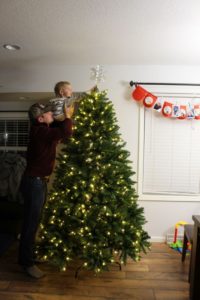Decoration
Origins of Christmas Tree Decorating Tradition

<p>The <strong>Christmas tree</strong> is perhaps one of the most iconic symbols of the holiday season. Decorated with lights, baubles, and sometimes garlands, these trees bring a festive spirit into our homes. But where did the tradition of decorating a Christmas tree come from? Let's delve into its origins and how this practice became a beloved holiday tradition worldwide.</p>
<h2>Historical Roots of the Christmas Tree</h2>
<p>The tradition of the <em>Christmas tree</em> as we know it today has a rich history, with roots that reach back centuries.</p>
<ul>
<li><strong>Ancient Civilizations:</strong> Even before Christianity, ancient civilizations like the Egyptians, Romans, and Vikings used evergreen plants in their winter celebrations. The evergreen, symbolizing life, was a way to ward off evil spirits and celebrate the promise of rebirth.</li>
<li><strong>Middle Ages:</strong> In the Middle Ages in Germany, there are references to setting up a 'Paradise Tree' on Christmas Eve. This was an apple-laden tree, representing the Tree of Knowledge from the biblical story of Adam and Eve. The practice slowly evolved, integrating into Christmas festivities.</li>
<li><strong>Martin Luther:</strong> A legend attributes the introduction of the Christmas tree with candles to the Protestant reformer Martin Luther. It's said he was so moved by the starlit trees while walking home one Christmas Eve that he recreated the scene for his family using a pine tree with candles.</li>
</ul>
<h2>Spread Across Europe</h2>
<p>Decorating a Christmas tree became more popular and widespread during the 17th and 18th centuries.</p>
<ul>
<li><strong>German Immigrants:</strong> German settlers brought the tradition to Pennsylvania and other parts of America, where it caught on, particularly in areas with significant German populations.</li>
<li><strong>England:</strong> Queen Victoria's consort, Prince Albert, who was German, popularized the Christmas tree in England after an illustration of the royal family around a Christmas tree was published in 1848. This image helped establish the tradition in British culture.</li>
<li><strong>Other Countries:</strong> The custom then spread to other parts of Europe like Sweden, where it was known as the 'Julgran,' and France, where it took on a more secular form, often decorated with ornaments representing contemporary life and amusements.</li>
</ul>
<h2>Modern Christmas Tree Traditions</h2>
<p>Today, the <em>Christmas tree</em> tradition has evolved into a global phenomenon, incorporating various customs and styles.</p>
<h3>Decorations</h3>
<ul>
<li><strong>Ornaments:</strong> Modern Christmas trees are adorned with a variety of decorations, from traditional glass baubles to handmade ornaments. Each family often has unique ornaments that might reflect cultural, personal, or familial significance.</li>
<li><strong>Lights:</strong> The shift from candles to electric lights brought about a safer and brighter way to illuminate the Christmas tree. The introduction of tree lights revolutionized the way trees were decorated.</li>
<li><strong>Star or Angel:</strong> At the top of many trees, a star or an angel can be found, representing the star of Bethlehem or the angel who announced the birth of Christ to the shepherds.</li>
</ul>
<h3>Types of Trees</h3>
<ul>
<li><strong>Natural vs. Artificial:</strong> While the traditional Christmas tree was an evergreen cut from nature, the advent of artificial trees in the 20th century allowed for a reusable and less environmentally damaging option.</li>
<li><strong>Unique Trees:</strong> Different cultures have adapted the tree tradition, using alternatives like palm trees in warmer climates or inverted trees, hanging from the ceiling, as a unique twist.</li>
</ul>
<h3>Placement and Usage</h3>
<ul>
<li><strong>Home:</strong> Families place their Christmas trees in their living rooms, often near windows to be seen from outside, or in central areas for gatherings around.</li>
<li><strong>Public Spaces:</strong> Public Christmas trees in town squares, malls, and other communal areas become a focal point for community gatherings and often feature elaborate decorations and lighting ceremonies.</li>
</ul>
<h2>The Cultural Significance</h2>
<p>Beyond the decorations and merrymaking, the Christmas tree holds a profound cultural significance:</p>
<ul>
<li><strong>Symbol of Life:</strong> The evergreen tree symbolizes life, continuity, and the hope for renewal amidst winter's starkness.</li>
<li><strong>Family Tradition:</strong> Decorating the tree is often a family activity, passing down traditions and creating memories. It represents family, warmth, and togetherness during the holiday season.</li>
<li><strong>Commercial and Secularization:</strong> The commercialization of Christmas, especially in the 20th century, saw the Christmas tree becoming a focal point of holiday marketing, selling not just trees but also the myriad decorations that accompany them.</li>
</ul>
<p>As we wrap up our exploration into the origins of the <em>Christmas tree</em> tradition, we see that it has evolved from ancient winter rituals into a symbol of joy, family, and togetherness. Whether adorned with lights, ornaments, or kept simple, the Christmas tree invites us to reflect on the past while embracing the spirit of Christmas with each twinkle and shimmer. </p>
<div class="faq-section">
<div class="faq-container">
<div class="faq-item">
<div class="faq-question">
<h3>Why do we put stars or angels on top of the Christmas tree?</h3>
<span class="faq-toggle">+</span>
</div>
<div class="faq-answer">
<p>The star represents the star of Bethlehem that guided the Wise Men to Jesus, while the angel symbolizes the announcement of Jesus' birth to the shepherds.</p>
</div>
</div>
<div class="faq-item">
<div class="faq-question">
<h3>What are some traditional Christmas tree decorations?</h3>
<span class="faq-toggle">+</span>
</div>
<div class="faq-answer">
<p>Traditional decorations include candles or lights, garlands, baubles, tinsel, candy canes, and handmade or family heirloom ornaments.</p>
</div>
</div>
<div class="faq-item">
<div class="faq-question">
<h3>How did the Christmas tree become popular in the United States?</h3>
<span class="faq-toggle">+</span>
</div>
<div class="faq-answer">
<p>German immigrants brought the tradition to America, where it became popular in Pennsylvania and spread across the country, particularly during the Victorian era.</p>
</div>
</div>
<div class="faq-item">
<div class="faq-question">
<h3>Can you use a live tree indoors?</h3>
<span class="faq-toggle">+</span>
</div>
<div class="faq-answer">
<p>Yes, live trees are commonly used indoors. Ensure they are well-watered to prevent drying and always keep them away from open flames or heat sources.</p>
</div>
</div>
<div class="faq-item">
<div class="faq-question">
<h3>What does an inverted Christmas tree symbolize?</h3>
<span class="faq-toggle">+</span>
</div>
<div class="faq-answer">
<p>An inverted Christmas tree can symbolize heaven's connection to earth, with the tip pointing towards heaven.</p>
</div>
</div>
</div>
</div>